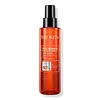What's inside
What's inside
 Key Ingredients
Key Ingredients

No key ingredients
 Benefits
Benefits

 Concerns
Concerns

No concerns
 Ingredients Side-by-side
Ingredients Side-by-side

Water
Skin ConditioningDipropylene Glycol
HumectantPolysilicone-29
Vp/Methacrylamide/Vinyl Imidazole Copolymer
Silicone Quaternium-18
EmollientGlycerin
HumectantTrideceth-6
EmulsifyingChamomilla Recutita Flower Extract
MaskingCalendula Officinalis Flower Extract
MaskingPolyimide-1
Potassium Sorbate
PreservativePhenoxyethanol
PreservativeTrideceth-12
EmulsifyingSodium Benzoate
MaskingChlorphenesin
AntimicrobialPotassium Benzoate
PreservativePhenylpropanol
MaskingDisodium EDTA
Propanediol
SolventCaprylyl Glycol
EmollientTocopherol
AntioxidantCitric Acid
BufferingWater, Dipropylene Glycol, Polysilicone-29, Vp/Methacrylamide/Vinyl Imidazole Copolymer, Silicone Quaternium-18, Glycerin, Trideceth-6, Chamomilla Recutita Flower Extract, Calendula Officinalis Flower Extract, Polyimide-1, Potassium Sorbate, Phenoxyethanol, Trideceth-12, Sodium Benzoate, Chlorphenesin, Potassium Benzoate, Phenylpropanol, Disodium EDTA, Propanediol, Caprylyl Glycol, Tocopherol, Citric Acid
 Reviews
Reviews

Ingredients Explained
These ingredients are found in both products.
Ingredients higher up in an ingredient list are typically present in a larger amount.
Citric Acid is an alpha hydroxy acid (AHA) naturally found in citrus fruits like oranges, lemons, and limes.
Like other AHAs, citric acid can exfoliate skin by breaking down the bonds that hold dead skin cells together. This helps reveal smoother and brighter skin underneath.
However, this exfoliating effect only happens at high concentrations (20%) which can be hard to find in cosmetic products.
Due to this, citric acid is usually included in small amounts as a pH adjuster. This helps keep products slightly more acidic and compatible with skin's natural pH.
In skincare formulas, citric acid can:
While it can provide some skin benefits, research shows lactic acid and glycolic acid are generally more effective and less irritating exfoliants.
Most citric acid used in skincare today is made by fermenting sugars (usually from molasses). This synthetic version is identical to the natural citrus form but easier to stabilize and use in formulations.
Read more about some other popular AHA's here:
Learn more about Citric Acid